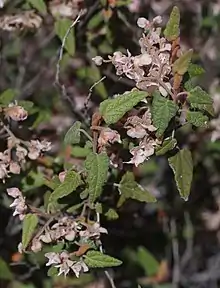Lasiopetalum molle
Lasiopetalum molle, commonly known as soft leaved lasiopetalum,[2] is a species of flowering plant in the family Malvaceae and is endemic to the south-west of Western Australia. It is an erect or spreading subshrub or shrub with hairy stems, thick and stiff egg-shaped leaves and pink flowers.
| Lasiopetalum molle | |
|---|---|
 | |
| In Wongan Hills | |
| Scientific classification | |
| Kingdom: | Plantae |
| Clade: | Tracheophytes |
| Clade: | Angiosperms |
| Clade: | Eudicots |
| Clade: | Rosids |
| Order: | Malvales |
| Family: | Malvaceae |
| Genus: | Lasiopetalum |
| Species: | L. molle |
| Binomial name | |
| Lasiopetalum molle | |
Description
Lasiopetalum molle is an erect or spreading subshrub or shrub that typically grows to a height of 0.3–1.5 cm (0.12–0.59 in), its young stems densely woolly-hairy with star-shaped hairs. The leaves are egg-shaped, mostly 14–24.3 mm (0.55–0.96 in) long and 6.7–12 mm (0.26–0.47 in) wide on a petiole 3.8–82 mm (0.15–3.23 in) long. The flowers are borne in dense clusters of nine to eleven flowers on a hairy peduncle 8–14.3 mm (0.31–0.56 in) long, the individual flowers on pedicels 1.8–5.3 mm (0.071–0.209 in) long with egg-shaped bracts 1.2–2.7 mm (0.047–0.106 in) long at the base. There are also pinkish, egg-shaped bracteoles 4.5–6.6 mm (0.18–0.26 in) long below the base of the sepals. The sepals are pink and petal-like, 5.8–7.5 mm (0.23–0.30 in) long and joined near the base, the lobes 4.8–6.5 mm (0.19–0.26 in) long. There are no petals and the anthers are 1.7–2.0 mm (0.067–0.079 in) long on a filament 0.5–0.8 mm (0.020–0.031 in) long. Flowering occurs from July to October.[2][3]
Taxonomy
Lasiopetalum molle was first formally described in 1863 by George Bentham in Flora Australiensis from specimens collected by James Drummond in the Swan River Colony.[4][5] The specific epithet (molle) means "soft".[6]
Distribution and habitat
This lasiopetalum grows in open mallee woodland from Wongan Hills to Newdegate in the Avon Wheatbelt and Mallee biogeographic regions of south-western Western Australia.[2]
Conservation status
Lasiopetalum molle is listed as "not threatened" by the Government of Western Australia Department of Biodiversity, Conservation and Attractions.[2]
References
- "Lasiopetalum molle". Australian Plant Census. Retrieved 24 March 2022.
- "Lasiopetalum molle". FloraBase. Western Australian Government Department of Biodiversity, Conservation and Attractions.
- Shepherd, Kelly A.; Wilkins, Carolyn F. (2018). "A taxonomic revision of species with a petaloid epicalyx bract allied to Lasiopetalum bracteatum (Malvaceae: Byttnerioideae)" (PDF). Nuytsia. 29: 171–173. Retrieved 24 March 2022.
- "Lasiopetalum molle". APNI. Retrieved 24 March 2022.
- Bentham, George; von Mueller, Ferdinand (1863). Flora Australiensis. Vol. 1. London: Lovell Reeve & Co. p. 266. Retrieved 24 March 2022.
- Sharr, Francis Aubi; George, Alex (2019). Western Australian Plant Names and Their Meanings (3rd ed.). Kardinya, WA: Four Gables Press. p. 254. ISBN 9780958034180.